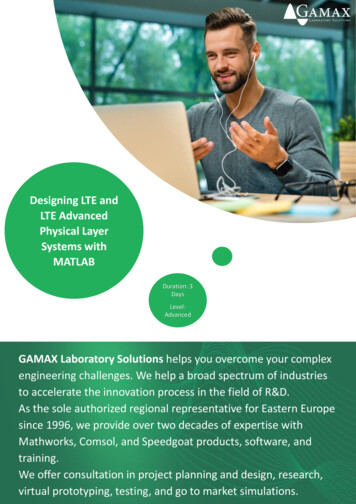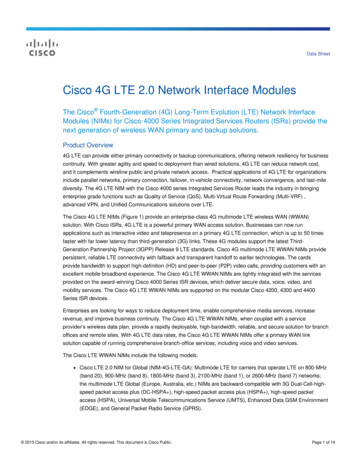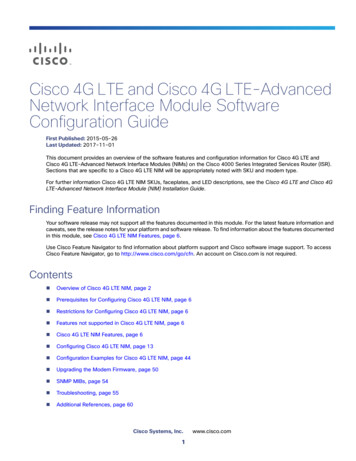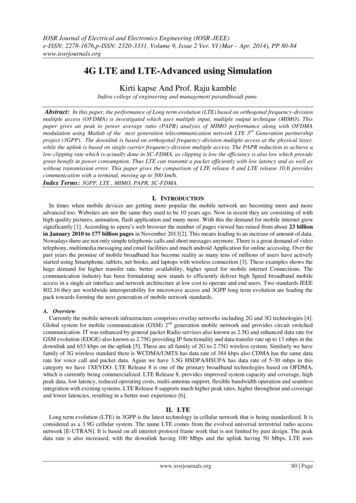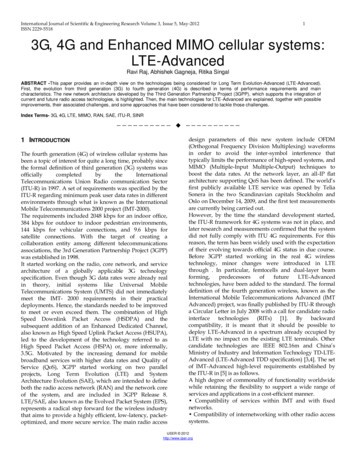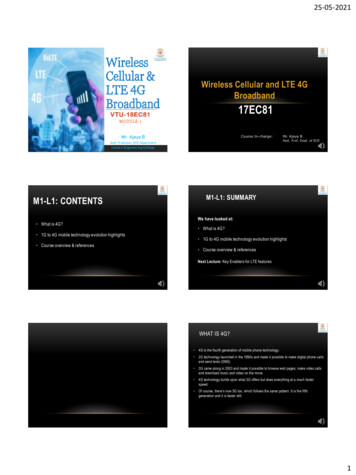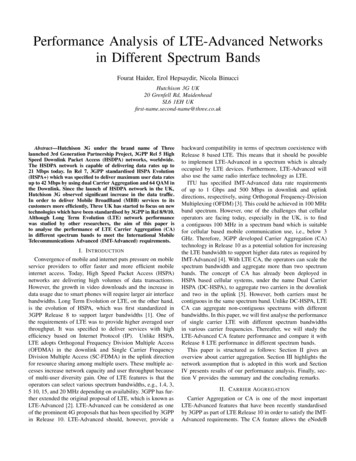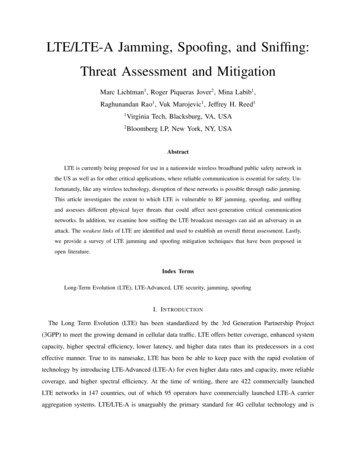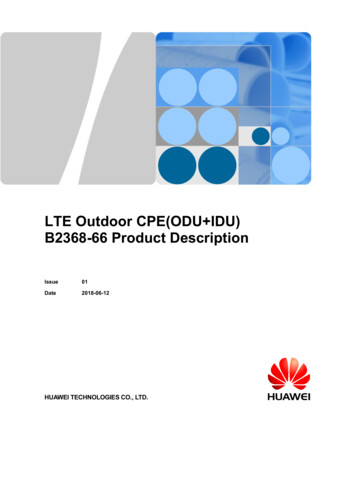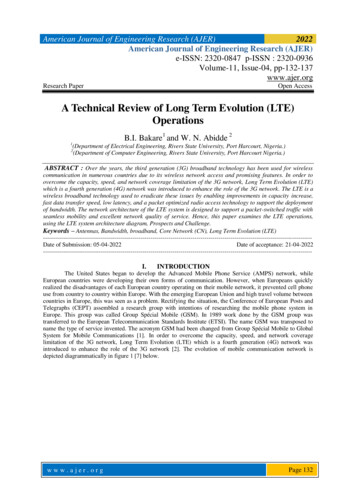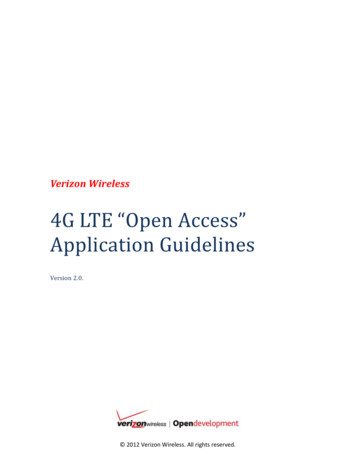
Transcription
Verizon Wireless4G LTE “Open Access”Application GuidelinesVersion 2.0. 2012 Verizon Wireless. All rights reserved.
Verizon Wireless - 4G LTE “Open Access” Application GuidelinesContents1234Introduction . 31.1Goal . 41.2Feedback . 4Application Guidelines . 42.1GSMA Application Guidelines . 42.2Network Aware Applications . 42.3Verizon Wireless Recommended Application Guidelines . 5Applications Compromising Verizon Wireless LTE Network or Users . 63.1Worst Application Practices . 63.2Customer Security and Privacy Exposure. 73.3Harmful Events to Verizon Wireless LTE network . 74G LTE Voluntary Application Test Program. 84.1Process . 84.2Fees and Contacts . 8Revision HistoryRevisionAmendmentsDate1.0Document creation09/10/102.0First revision – including GSMA Guidelines reference12/11/12 2012 Verizon Wireless. All rights reserved.2
Verizon Wireless - 4G LTE “Open Access” Application Guidelines1IntroductionThese application guidelines provide a set of recommended practices and technical standards fordevelopers of 4G LTE applications to facilitate access to Verizon’s 4G LTE network while protectingagainst objectionable interference with other users’ of the network and ensuring network security. Ifyour application is targeted to be preloaded on a Verizon Wireless device or launched pursuant to anagreement with Verizon Wireless, more specific and stringent requirements may be provided byVerizon Wireless.Our philosophy with respect to applications that use our 4G LTE network is that we are open. We havethe best network and we want our customers to leverage it to drive success for their personal andbusiness needs. We also want developers to be able to bring devices and applications to the networkthat will result in our customers, and their customers, having more and innovative choices.At this time, Verizon Wireless does not require advance certification for applications that use our 4G LTEnetwork. This is true both in the case of applications that are designed specifically to work on theVerizon Wireless 4G LTE network, or that may be used on that network by consumers but that will bemarketed by the developer through a Non-Verizon Marketing Channel (NVMC). By contrast, wecurrently have a certification program to ensure modules/devices developed by third parties arecompliant with our published technical specifications for the 4G LTE network.While there is no advance certification requirement for 4G LTE applications, Verizon Wireless doesmonitor its network and work collaboratively with application developers, app stores, and our customersto ensure that applications operating on our network do not interfere with operation of the network ofwith other users of the network. The guidelines in this document will be implemented as our standardsto review the behavior of applications developed for use on our 4G LTE network.This document provides 4G LTE application developers guidance with respect to acceptable applicationbehavior. This document thus complements the existing 4G LTE module/device certificationspecifications already published.Verizon Wireless reserves the right to take the appropriate remedial action against applications in theevent of the potentially harmful behaviors described in this document. Since the behavior of allpotential applications using the 4G LTE network cannot be predicted, the information detailed in thisguideline is necessarily not comprehensive of all acceptable or unacceptable application behaviors.Verizon Wireless reserves the right to take appropriate remedial action for applications performing in aharmful manner even if the behavior is not specifically noted herein.Verizon Wireless reserves the right to change this policy in the future, and to institute a formalapplication certification program or test plan without regard to marketing channel. We will giveinterested parties notice of any such change in policy on the Open Development web portal where the4G LTE device technical specifications are posted. 2012 Verizon Wireless. All rights reserved.3
Verizon Wireless - 4G LTE “Open Access” Application Guidelines1.1GoalThe Verizon Wireless network is a shared resource among all Verizon Wireless customers. It is importantthat no application has a detrimental effect on the overall operation of the network or on othercustomers, such as blocking access to the network, causing objectionable interference to other users,and/or threatening the security of users or the network. Applications developed for use on the networkshould be well behaved when using shared resources, limited resources, or resources required tomaintain customer privacy and security.The application developer is responsible for the user experience, functionality and quality of itsapplications as well as compliance with all applicable laws. The specifications in this guideline areintended to ensure that applications are safe for the network and do not violate the security or privacyof customers or otherwise harm users of the network. Applications that are found to compromise theLTE Verizon network, user security or privacy, or in general do not adhere to good engineering practicesto avoid interference and/or harm to the network or other users are subject to appropriate remedialactions by Verizon Wireless, including, but not limited to, disabling the application from operating on thenetwork. Likewise, Verizon Wireless may take action to address particular applications as needed tocomply with applicable law. To the extent any behavior is addressed in the Verizon Wireless devicetechnical specifications, those requirements also will be enforced.1.2FeedbackWe are always interested in receiving your feedback. Please contact us with your comments andsuggestions at n Guidelines2.1GSMA Application GuidelinesVerizon Wireless has adopted the GSMA recommended practices for application development publishedat -for-smarter-phones/. These GSMA guidelinesare being used by Verizon Wireless as a baseline for recommended practices for applications that usethe 4G LTE network, with the addition of Verizon Wireless specific guidelines and requirements.Compliance with the GSMA guidelines is intended to help prevent objectionable interference byapplications or their users with other users of Verizon’s 4G LTE network as well as to protect the securityof Verizon’s network and its users.2.2Network Aware ApplicationsNetwork Aware Applications make use of Verizon Wireless’s network resources or features. Examplesare applications that explicitly create network connections (sockets), applications that use HTTP services, 2012 Verizon Wireless. All rights reserved.4
Verizon Wireless - 4G LTE “Open Access” Application Guidelinesapplications that generate SMS messages, etc. The design and implementation of Network AwareApplications should make efficient and intelligent use of network resources.The number and frequency of connections to the network should be minimized such that the applicationonly requests what is necessary for the correct and reliable operation of the application. Theapplication should detect error conditions of the network and/or remote servers and act to avoid addingunnecessary congestion to the network. The bandwidth utilized by the applications should be optimizedin order to maintain reliable use of the application, maintain a high level of responsiveness for the user,and reduce opportunities for network congestion. Applications that fail to adhere to these bestpractices may adversely affect the 4G LTE network and/or users of the network, and may be subject toremedial action if necessary to protect the network or users.2.3Verizon Wireless Recommended Application GuidelinesThe following table outlines a set of recommended industry practices that Verizon Wirelessrecommends to all application developers. This set of guidelines is based on the GSMArecommendations with the addition of the Security guideline which was only partially addressed byGSMA.RelevanceGuidelineFor more details, seefollowing GSMAdocument sectionsUsability/ AsynchronyTechniques such as pipelining and asynchrony shouldSections 2.2.1, 4.1.1,be used to ensure that the client operates smoothly.4.2.1, 4.3.1Use strategies that minimize and optimize data trafficSection 2.3Efficient network connectionusageand avoid unnecessary data transfers, especially whenroaming.Background/ foreground modes Deactivate background processes when not required.Section 2.3, 3.6, 4.2.8Background/ foregroundmodes, SchedulingDesign polling applications to aggregate their networkactivities.Section 2.3, 3.6, 4.2.9Connection loss and errorhandlingApplications should be resilient to changing networkconditions and errors.Section 3.2CompressionApplications using HTTP should support compression.Section 3.5Data pushApplications should use push services in preference topolling.Section 3.6, 4.2.5, 4.3.3SecurityApplications should protect the customer content on thedevice and during data exchange with the cloud serversSection 3.3Table 1 – Verizon Wireless Recommended Application Guidelines 2012 Verizon Wireless. All rights reserved.5
Verizon Wireless - 4G LTE “Open Access” Application Guidelines3Applications Compromising Verizon Wireless LTE Network or UsersApplications that are found to compromise the Verizon Wireless 4G LTE network, user security or privacyare, as set out below, inconsistent with applicable technical standards and could be subjected to remedialaction by Verizon Wireless, including, but not limited to, disabling the application from operating on thenetwork.Verizon Wireless will consider taking remedial action:i.ii.iii.iv.v.3.1when an application implementation reveals what is considered an industry worst practiceresulting in interference and/or a significant adverse impact on the user and/or the network ;when an application exposes customers of Verizon Wireless directly to a security and/or a privacyrisk, including but not limited to sending Spam or malicious code through customer accounts, orpotentially giving customers the ability to see communications destined for other customers;when an application exploits the Verizon Wireless LTE network to enable the unauthorized resaleof Verizon Wireless services;when an application exposes directly and/or indirectly the Verizon Wireless LTE network toharmful events such as denial of service and security attacks;when such action is needed to comply with applicable laws.Worst Application PracticesThe following application development practices are considered to significantly impact customer use ofthe device and/or the network:3.1.1 3.1.2 Application blocks the device transition to sleep modeCustomer Impact: Battery life of the device significantly degraded.Prevention and/or Remediation: Deactivate background processes when not required (seeSection 2.3, 3.6, 4.2.8 of GSMA Guidelines).Application syncs with cloud server on exact same time scheduleNetwork Impact: Simultaneous spike of connections triggered by the same application runningon multiple devices and resulting potentially in denial of service attack.Customer Impact: Response time and sync schedule of the application could be potentiallydelayed.Prevention and/or Remediation: Use strategies that minimize and optimize data traffic and avoidunnecessary data transfers (see Section 2.3 of GSMA Guidelines). 2012 Verizon Wireless. All rights reserved.6
Verizon Wireless - 4G LTE “Open Access” Application Guidelines3.1.3 Handling connection errors to cloud server application exhibits high frequency of retries forlong period of time Network Impact: High frequency of retries sustained for long period of time can result potentiallyin denial of service attack on cloud server and on network elements.Customer Impact: Battery life of the device significantly degraded.Prevention and/or Remediation: Applications should be resilient to changing network conditionsand errors (see Section 3.2 of GSMA Guidelines). 3.1.4 Attempting to impersonate Verizon Wireless or using the Verizon Wireless name, logo, orother marks without consent Customer Impact: Potential confusion over whether applications have been developed orauthorized by Verizon Wireless and/or potential privacy and security threats resulting from thatconfusion.Prevention and/or Remediation: Applications should not suggest or imply an association withVerizon Wireless without the consent of Verizon Wireless. 3.2 3.3 Customer Security and Privacy ExposureCustomer Impact: Major security and/or privacy threat to user and device content. This mightinclude malware used to gain control of user’s device without user knowledge, and/or capturesconfidential user data, such as user IDs, location, contact list, browsing history, withoutnotification to user. This also may include applications that gain access to the accountinformation of Verizon Wireless customers without their knowledge or consent.Prevention and/or Remediation: Security (see Section 3.3 of GSMA Guidelines).Harmful Events to Verizon Wireless LTE networkNetwork Impact: Application events (intentional or not) that can directly or indirectly constitute adenial of service or a security attack on Verizon Wireless LTE network elements.Customer Impact: User experience affected due to potential disruption of service.Prevention and/or Remediation:o Use strategies that minimize and optimize data traffic and avoid unnecessary data transfers(see Section 2.3 of GSMA Guidelines).o Design polling applications to aggregate their network activities (see Section 2.3, 3.6, 4.2.9 ofGSMA Guidelines) 2012 Verizon Wireless. All rights reserved.7
Verizon Wireless - 4G LTE “Open Access” Application Guidelines44G LTE Voluntary Application Test Program4.1ProcessIf you are considering the distribution of an application on the Verizon Wireless 4G LTE network throughan NVMC and would like it to be tested for use on Verizon Wireless devices, please contact one of ourapproved testing houses listed below.Please note that this voluntary 4G LTE application test program is designed to provide assurance thatapplications will perform well on the Verizon Wireless network and devices. Passing these tests does notguarantee that the applications will always perform well. And, passing these tests does not insulate theapplication from remedial action if the application, or one of its iterations or revisions, performs in aharmful manner in violation of these guidelines. Verizon Wireless assumes no liability for the applicationdistributed through an NVMC and our Customer Care team will not be able to support customercomplaints related to applications distributed through such channels.4.2Fees and ContactsApplication certification will be at the expense of the developer.Please contact the approved test labs below for current pricing and test procedures.IntertekRobbie PayneICT Sales ManagerOffice: (859)226-1000Fax: (859)226-1050Email: Robbie.Payne@Intertek.comWeb Site: -------------------------------------------P3 CommunicationsRon HousenickVP OperationsOffice: (973) 984-6050Fax: (973) 689-2760Email: Ron.Housenick@P3-Group.comWeb Site: http://www.p3-group.com/ 2012 Verizon Wireless. All rights reserved.8
the 4G LTE network, with the addition of Wireless specific guidelines and requirements.Verizon Compliance with the GSMA guidelines is intended to prevent objectionable interference by help applications or their users with other users of Verizon's 4G LTE network as well as to protect the security of Verizon's network and its users.

